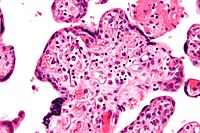
Photo from wikipedia
BACKGROUND There are critical molecular mechanisms that can be activated to induce myocardial repair and in humans this is most efficient during fetal development. The timing of heart development in… Click to show full abstract
BACKGROUND There are critical molecular mechanisms that can be activated to induce myocardial repair and in humans this is most efficient during fetal development. The timing of heart development in relation to birth and the size/electrophysiology of the heart are similar in humans and sheep, providing a model to investigate the repair capacity of the mammalian heart and how this can be applied to adult heart repair. METHODS Myocardial infarction was induced by ligation of the left anterior descending coronary artery in fetal (105d gestation when cardiomyocytes are proliferative) and adolescent sheep (6 months of age when all cardiomyocytes have switched to an adult phenotype). An ovine gene microarray was used to compare gene expression in sham and infarcted (remote, border and infarct areas) cardiac tissue from fetal and adolescent hearts. RESULTS The gene response to myocardial infarction was less pronounced in fetal compared to adolescent sheep hearts and there were unique gene responses at each age. There were also region-specific changes in gene expression between each age, in the infarct tissue, tissue bordering the infarct, and tissue remote from the infarction. CONCLUSIONS In response to myocardial infarction, there were specific changes in genes within pathways of mitochondrial oxidation, muscle contraction, and haematopoietic cell lineages, suggesting that the control of energy utilisation and immune function are critical for effective heart repair. The more restricted gene response in the fetus may be an important factor in its enhanced capacity for cardiac repair.
Journal Title: Physiological genomics
Year Published: 2020
Link to full text (if available)
Share on Social Media: Sign Up to like & get
recommendations!